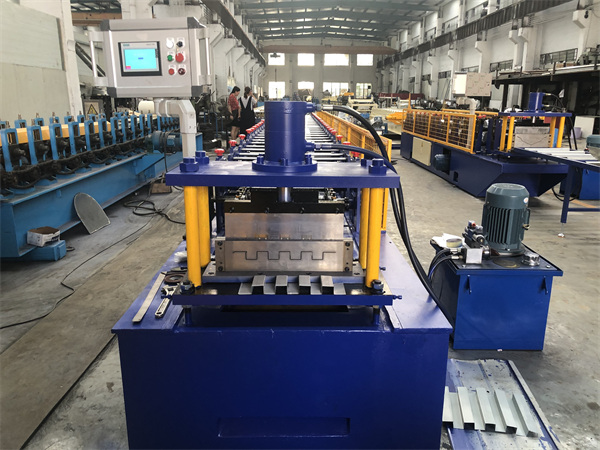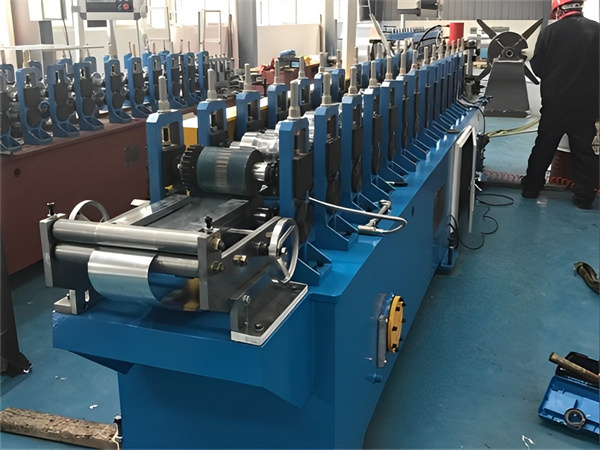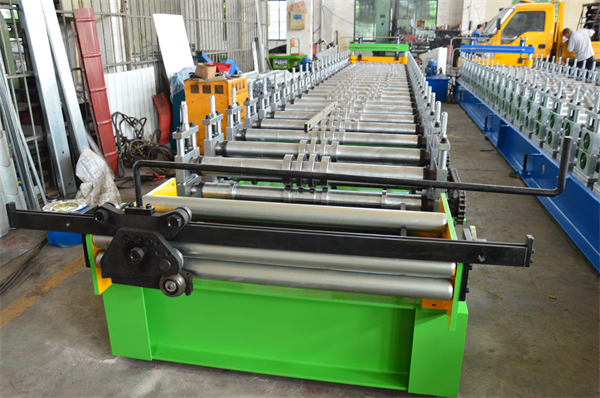1. Введение
В мире хранения сыпучих материалов стальные силосы играют жизненно важную роль в сохранении и защите различных товаров, включая зерно, цемент и другие материалы. Эти цилиндрические конструкции славятся своей прочностью, экономичностью и простотой сборки. Одним из важнейших компонентов при производстве стальных силосов является стальной силос валковая формовочная машина. В этой статье мы рассмотрим, что это за машина, как она работает, ее преимущества и различные области применения.
2. Что такое машина для формовки стальных силосов?
Станок для формовки стальных бункеров - это специализированное оборудование, используемое в процессе производства стальных бункеров. Она отвечает за преобразование плоских стальных рулонов в точные и бесшовные цилиндрические формы. Машина работает по принципу непрерывной гибки, когда стальные рулоны проходят через ряд роликов, которые постепенно придают материалу нужный профиль.

3. Преимущества использования машины для формовки стальных силосов
Использование вальцовочной машины для производства стальных силосов имеет множество преимуществ по сравнению с традиционными методами строительства силосов. К числу основных преимуществ относятся:
- Экономичность: Процесс валковой формовки оптимизирует использование материалов, сокращает количество отходов и снижает производственные затраты.
- Высокая точность: Машина обеспечивает равномерность и точность формы и размеров силоса, что позволяет получить бесшовную конструкцию.
- Экономия времени: Автоматизированный процесс значительно сокращает время производства, позволяя ускорить сборку и доставку.
- Универсальность: Станки для формовки стальных силосов могут производить различные профили силосов, удовлетворяя различные потребности в хранении.
- Долговечность: Получаемые стальные силосы прочны и устойчивы к воздействию окружающей среды, что обеспечивает их долговременную надежность.
4. Как работает машина для формовки стальных силосов?
Работа машины для формовки стальных силосов включает в себя несколько последовательных этапов:
- Разматывание: Процесс начинается с подачи рулонов плоской стали на станок, где материал разматывается.
- Формовка рулонов: Размотанная сталь проходит через ряд роликов, постепенно изгибающих ее в нужную форму.
- Резка: После достижения нужной длины станок разрезает сталь на отдельные сегменты.
- Сварка: Затем сегменты свариваются вместе, образуя непрерывный бесшовный цилиндр.
- Гофрирование (опционально): В особых случаях машина может добавить гофры к стальному бункеру, обеспечивая дополнительную прочность.
- Формирование верхней и нижней части: Наконец, машина формирует верхнюю и нижнюю части стального бункера.
5. Основные компоненты машины для формовки стальных силосов
Станок для формовки стальных силосов состоит из нескольких основных компонентов, которые работают вместе для производства высококачественных силосов. К этим компонентам относятся:
5.1 Устройство для формовки рулонов
Вальцы - это сердце машины, состоящее из ряда роликов, которые постепенно изгибают плоскую сталь в нужную цилиндрическую форму.
5.2 Режущее устройство
Режущий блок отвечает за точную резку непрерывной стали на отдельные сегменты необходимой длины.
5.3 Система управления
Система управления управляет всем процессом, обеспечивая точность, автоматизацию и безопасность во время работы.
5.4 Система обработки материалов
Система перемещения материалов подает рулоны плоской стали на станок и управляет движением сформированных сегментов.

6. Различные типы машин для формовки стальных силосов
Существует несколько типов машин для формовки стальных бункеров, каждый из которых отвечает определенным требованиям. Два основных типа:
6.1 Машина для формовки спиральных стальных силосов
Станок для формовки спиральных стальных силосов специализируется на производстве силосов спиральной формы, которые отличаются повышенной вместимостью и прочностью конструкции.
6.2 Гофрированная стальная силосная роликовая формовочная машина
Станок для формовки гофрированных стальных силосов используется для производства гофрированных силосов, которые подходят для широкого спектра материалов.
7. Факторы, которые следует учитывать при выборе машины для формовки стальных силосов
Выбор правильной машины для формовки стальных силосов имеет решающее значение для обеспечения бесперебойного производства и оптимального качества силосов. Необходимо учитывать следующие ключевые факторы:
7.1 Мощность и размер
Производительность машины должна соответствовать производственным требованиям, и она должна быть способна производить силос нужного размера.
7.2 Совместимость материалов
Машина должна быть совместима с типом и толщиной стали, необходимой для конкретного проекта силоса.
7.3 Уровень автоматизации
Более высокий уровень автоматизации приводит к повышению эффективности и сокращению ручного труда, что способствует ускорению производства.
7.4 Техническое обслуживание и поддержка
Надежная послепродажная поддержка и техническое обслуживание жизненно важны для поддержания бесперебойной работы машины и минимизации времени простоя.
8. Установка и ввод в эксплуатацию машины для формовки стальных силосов
Процесс установки и ввода в эксплуатацию имеет решающее значение для обеспечения надлежащего функционирования и безопасности машины. В этот процесс входят следующие этапы:
- Подготовка фундамента: Машине требуется прочный фундамент, чтобы выдерживать ее вес и вибрации во время работы.
- Размещение машины: Аккуратно установите машину на фундамент, обеспечив правильное выравнивание и уровень.
- Подключение питания: Подключите машину к надежному источнику питания, соблюдая правила техники безопасности.
- Пробный запуск: Проведите пробный запуск, чтобы проверить все функции и регулировки перед полномасштабным производством.
- Обучение: Обучение операторов работе с машиной, техническому обслуживанию и правилам безопасности.

9. Меры безопасности и предосторожности
Обеспечение безопасных условий труда имеет первостепенное значение при эксплуатации машины для формовки стальных бункеров. К числу основных мер безопасности относятся:
- Защитные средства: Операторы должны использовать соответствующие средства защиты, такие как перчатки, очки и средства защиты ушей.
- Аварийный останов: Машина должна иметь легкодоступные кнопки аварийной остановки для прекращения работы в случае возникновения аварийных ситуаций.
- Регулярное обслуживание: Регулярно осматривайте и обслуживайте машину, чтобы выявить потенциальные угрозы безопасности.
10. Техническое обслуживание и устранение неисправностей
Для поддержания оптимального состояния машины для формовки стальных бункеров необходимо регулярное техническое обслуживание и оперативное устранение неисправностей. Регулярное техническое обслуживание включает в себя:
- Очистка и смазка: Следите за чистотой и смазкой машины, чтобы предотвратить появление ржавчины и обеспечить бесперебойную работу.
- Инспекции: Регулярно проверяйте компоненты на предмет износа и своевременно заменяйте поврежденные детали, чтобы избежать перебоев в производстве.
- Калибровка: Периодически калибруйте машину для обеспечения точного и аккуратного формования.
- Электрические проверки: Регулярно проверяйте электрические соединения и компоненты, чтобы избежать проблем с электричеством.
При устранении неисправностей операторы должны выполнить следующие действия:
- Определите проблему: Наблюдайте за поведением машины и выявляйте любые аномальные признаки или неисправности.
- Проверьте, нет ли препятствий: Убедитесь в отсутствии засоров или посторонних предметов, препятствующих работе машины.
- Осмотрите компоненты: Осмотрите все компоненты и соединения на наличие признаков повреждения или износа.
- Пособия для консультантов: Рекомендации и решения по устранению неисправностей см. в руководстве к машине.
- Обратитесь за профессиональной помощью: Если проблема не решается или выходит за рамки компетенции оператора, обратитесь за помощью к квалифицированному техническому специалисту.
11. Применение машин для формовки стальных силосов
Машины для формовки стальных силосов находят применение в различных отраслях промышленности для хранения и консервации. К числу наиболее распространенных областей применения относятся:
- Сельское хозяйство: Стальные силосы широко используются для хранения зерна, семян и другой сельскохозяйственной продукции.
- Цементная промышленность: Стальные силосы используются для хранения цемента и других строительных материалов.
- Пищевая промышленность: Они используются для хранения пищевых ингредиентов и продуктов переработки.
- Химическая промышленность: В стальных силосах надежно хранятся различные химические вещества.
- Управление отходами: Стальные силосы используются для хранения и переработки отходов.
12. Будущее машин для формовки стальных силосов
По мере развития технологий и поиска более эффективных и экологичных решений будущее машин для формовки стальных силосов выглядит многообещающим. Некоторые потенциальные разработки включают:
- Усовершенствованная автоматизация: Машины с повышенной автоматизацией и интеграцией искусственного интеллекта для повышения эффективности и производительности.
- Улучшенная совместимость с материалами: Машины, способные обрабатывать широкий спектр материалов, предназначены для различных отраслей промышленности.
- Энергоэффективность: Более энергоэффективные машины с пониженным энергопотреблением.
- Умное обслуживание: Внедрение технологий предиктивного обслуживания для сокращения времени простоя и повышения производительности.

13. Заключение
В заключение следует отметить, что станки для формовки стальных силосов играют важную роль в производстве прочных и надежных стальных силосов, используемых для хранения сыпучих материалов. Они обладают многочисленными преимуществами, включая экономичность, точность и универсальность. При выборе валковой машины для производства стальных силосов следует тщательно учитывать такие факторы, как производительность, совместимость материалов и уровень автоматизации. Кроме того, правильная установка, регулярное техническое обслуживание и соблюдение мер безопасности гарантируют долговечность и безопасную работу машины.
Часто задаваемые вопросы
1. Может ли машина для формовки стальных силосов производить различные формы силосов?
Да, станок для формовки стальных силосов может быть разработан для производства различных профилей силосов для удовлетворения различных потребностей в хранении.
2. Какие материалы могут быть использованы в машине для формовки стальных силосов?
Чаще всего в таких машинах используется сталь. Однако некоторые машины могут быть совместимы с другими металлами, например, с алюминием.
3. Просты ли в эксплуатации машины для формовки стальных бункеров?
Да, большинство современных машин оснащены удобным управлением и функциями автоматизации, что делает их относительно простыми в эксплуатации.
4. Сколько времени занимает установка машины для формовки стальных силосов?
Процесс установки обычно занимает несколько дней, в зависимости от сложности оборудования и подготовленности площадки.
5. Могут ли машины для формовки стальных бункеров быть настроены под конкретные требования?
Да, производители могут изготовить машины на заказ, чтобы удовлетворить конкретные требования клиентов по производительности, размеру и уровню автоматизации.
